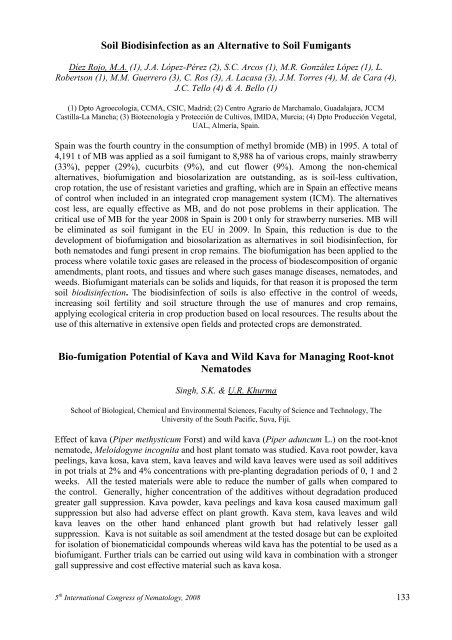TABLE CONTENTS
How different or similar are nematode communities - International ...
How different or similar are nematode communities - International ...
Create successful ePaper yourself
Turn your PDF publications into a flip-book with our unique Google optimized e-Paper software.
Soil Biodisinfection as an Alternative to Soil Fumigants<br />
Díez Rojo, M.A. (1), J.A. López-Pérez (2), S.C. Arcos (1), M.R. González López (1), L.<br />
Robertson (1), M.M. Guerrero (3), C. Ros (3), A. Lacasa (3), J.M. Torres (4), M. de Cara (4),<br />
J.C. Tello (4) & A. Bello (1)<br />
(1) Dpto Agroecología, CCMA, CSIC, Madrid; (2) Centro Agrario de Marchamalo, Guadalajara, JCCM<br />
Castilla-La Mancha; (3) Biotecnología y Protección de Cultivos, IMIDA, Murcia; (4) Dpto Producción Vegetal,<br />
UAL, Almería, Spain.<br />
Spain was the fourth country in the consumption of methyl bromide (MB) in 1995. A total of<br />
4,191 t of MB was applied as a soil fumigant to 8,988 ha of various crops, mainly strawberry<br />
(33%), pepper (29%), cucurbits (9%), and cut flower (9%). Among the non-chemical<br />
alternatives, biofumigation and biosolarization are outstanding, as is soil-less cultivation,<br />
crop rotation, the use of resistant varieties and grafting, which are in Spain an effective means<br />
of control when included in an integrated crop management system (ICM). The alternatives<br />
cost less, are equally effective as MB, and do not pose problems in their application. The<br />
critical use of MB for the year 2008 in Spain is 200 t only for strawberry nurseries. MB will<br />
be eliminated as soil fumigant in the EU in 2009. In Spain, this reduction is due to the<br />
development of biofumigation and biosolarization as alternatives in soil biodisinfection, for<br />
both nematodes and fungi present in crop remains. The biofumigation has been applied to the<br />
process where volatile toxic gases are released in the process of biodescomposition of organic<br />
amendments, plant roots, and tissues and where such gases manage diseases, nematodes, and<br />
weeds. Biofumigant materials can be solids and liquids, for that reason it is proposed the term<br />
soil biodisinfection. The biodisinfection of soils is also effective in the control of weeds,<br />
increasing soil fertility and soil structure through the use of manures and crop remains,<br />
applying ecological criteria in crop production based on local resources. The results about the<br />
use of this alternative in extensive open fields and protected crops are demonstrated.<br />
Bio-fumigation Potential of Kava and Wild Kava for Managing Root-knot<br />
Nematodes<br />
Singh, S.K. & U.R. Khurma<br />
School of Biological, Chemical and Environmental Sciences, Faculty of Science and Technology, The<br />
University of the South Pacific, Suva, Fiji.<br />
Effect of kava (Piper methysticum Forst) and wild kava (Piper aduncum L.) on the root-knot<br />
nematode, Meloidogyne incognita and host plant tomato was studied. Kava root powder, kava<br />
peelings, kava kosa, kava stem, kava leaves and wild kava leaves were used as soil additives<br />
in pot trials at 2% and 4% concentrations with pre-planting degradation periods of 0, 1 and 2<br />
weeks. All the tested materials were able to reduce the number of galls when compared to<br />
the control. Generally, higher concentration of the additives without degradation produced<br />
greater gall suppression. Kava powder, kava peelings and kava kosa caused maximum gall<br />
suppression but also had adverse effect on plant growth. Kava stem, kava leaves and wild<br />
kava leaves on the other hand enhanced plant growth but had relatively lesser gall<br />
suppression. Kava is not suitable as soil amendment at the tested dosage but can be exploited<br />
for isolation of bionematicidal compounds whereas wild kava has the potential to be used as a<br />
biofumigant. Further trials can be carried out using wild kava in combination with a stronger<br />
gall suppressive and cost effective material such as kava kosa.<br />
5 th International Congress of Nematology, 2008 133


